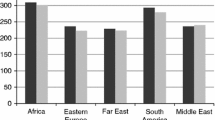Abstract
Logistics performance has become a decisive factor in export competitiveness. At the same time, and as a result of the continuous enlargement processes it has undergone, the European Union (EU) is a very interesting case to study how the reforms that enhance logistics performance have affected exports. Therefore, this paper aims to analyse the importance of logistics performance in regard to EU exports over the period 2005–2010 in an attempt to identify possible advances on behalf of Member States. Several gravity equations are estimated using the Logistics Performance Index (LPI) and its components as characteristic proxy variables of trade facilitation. In order to avoid the possible heterogeneity caused by sample bias, the two-stage model proposed by Heckman is used. The estimations of the gravity models using the two-stage Heckman model for all 26 EU countries have led us to conclude that logistics was more important for exporting nations than importing nations in both 2005 and 2010, reinforcing the interest in the exporter side of the paper. In reference to the components of the LPI, Competence and Tracking has acquired greater importance in recent years, in keeping with the weak domestic demand in European countries and the search for new international markets.


Similar content being viewed by others
Notes
All 26 European countries have been removed in order to consider only non-EU exports.
The coefficients of all the variables have been standardised in order to facilitate comparison.
References
Anderson JE (1979) A theorical foundation to the gravity equation. Am Econ Rev 69: 106–116 http://www.jstor.org/stable/1802501
Anderson J, Van Wincoop E (2003) Gravity with gravitas: a solution to the border puzzle. Am Econ Rev 93:170–192. doi:10.1257/000282803321455214
Arvis JF, Mustra M, Ojala L, Shepherd B, Saslavsky D (2007) Connecting to compete: trade logistics in the global economy. World Bank, Washington
Arvis JF, Mustra M, Panzer J, Ojala L, Naula T (2010) Connecting to compete: trade logistics in the global economy. World Bank, Washington
Arvis JF, Mustra M, Ojala L, Shepherd B, Saslavsky D (2012) Connecting to compete: trade logistics in the global economy. World Bank, Washington
Behar A, Manner P (2008) Logistics and exports. African economics working paper series 293. CSAE WPS/2008-13. University of Oxford, Oxford
Behar A, Venables AJ (2010) Transport costs and international trade. In: Palma A, Lindsey R, Quinet E, Vickerman R (eds) Handbook of transport economics. Edward Elgar, pp 97–115
Behar A, Manners P, Nelson B (2009) Exports and logistics. Oxford Department of Economics Discussion Paper 439
Bergstrand JH (1985) The gravity equation in international trade: some microeconomic foundations and empirical evidence. Rev Econ Stat 71: 143–153. http://www.jstor.org/stable/1925975
Bergstrand JH (1989) The generalized gravity equation, monopolistic competition, and the factor-proportions theory in international trade. Rev Econ Stat 67: 474–481. http://www.jstor.org/stable/1928061
Breuss F, Egger P (1999) How reliable are estimations of east-west trade potencials based on cross-section gravity analysis? Empirica 26:86–89. doi:10.1023/A:1007011329676
CILT (2012) Available at http://www.ciltuk.org.uk/pages/royalcharter. Accessed 02 Aug 2012
Felipe J, Kumar U (2012) The role of trade facilitation in Central Asia: a gravity model. East Eur Econ 50:5–20. doi:10.2753/EEE0012-875500401
Heckman J (1979) Sample selection bias as a specification error. Econometrica 47: 153–161. http://www.jstor.org/stable/1912352
Helpman E, Krugman P (1985) Market structure and foreign trade. Increasing returns, imperfect competition and the international economy. The MIT Press, Cambridge, MA/London
Hertel T, Mirza T (2009) The role of trade facilitation in South Asian economic integration. Study on intraregional trade and investment in South Asia. ADB, Mandaluyong City
Hollweg C, Wong M-H (2009) Measuring regulatory restrictions in logistics services. ERIA Discussion Paper Series, no. 14
Jane C–C (2011) Performance evaluation of logistic systems under cost and reliability considerations. Transp Res E-Log 47:130–137. doi:10.1016/j.tre.2010.09.012
Keskin MH (2012) The exigencies of the common logistics policy for European community and the deconstruction of the common transportation policy. Afr J Bus Manage 6:10697–10707. doi:10.5897/AJBM11.1523
Korinek J, Sourdin P (2011) To what extent are high-quality logistics services trade facilitating? Oecd trade policy working papers 108. OECD Publishing
Langley C, Coyle J, Gibson B, Novak R, Bardi E (2008) Managing supply chain: a logistics approach. South–Western College Publishing, London
Mangan J, Lalwani C, Butcher C (2008) Global logistics and supply chain management. Wiley John & Sons, Inc., Hoboken, NJ
Martí ML, Puertas R, García L (2012) Relevance of trade facilitation in emerging countries′s export. J Int Trade Eco Dev. http://www.tandfonline.com/doi/abs/10.1080/09638199.2012.698639
Requena F, Llano C (2010) The border effects in Spain: an industrial-level analysis. Empirica 37:455–476. doi:10.1007/s10663-010-9123-6
Rushton A, Oxley J, Croucher P (2009) The handbook of logistics and distribution management. Kogan Page, London
Vilko J, Karandassov B, Myller E (2011) Logistic infrastructure and its effects on economic development. China–USA Bus Rev 10:1152–1167
World Bank (2010) Trade and transport facilitation assessment: a practical toolkit for country implementation. World Bank, Washington
Author information
Authors and Affiliations
Corresponding author
Rights and permissions
About this article
Cite this article
Puertas, R., Martí, L. & García, L. Logistics performance and export competitiveness: European experience. Empirica 41, 467–480 (2014). https://doi.org/10.1007/s10663-013-9241-z
Published:
Issue Date:
DOI: https://doi.org/10.1007/s10663-013-9241-z




